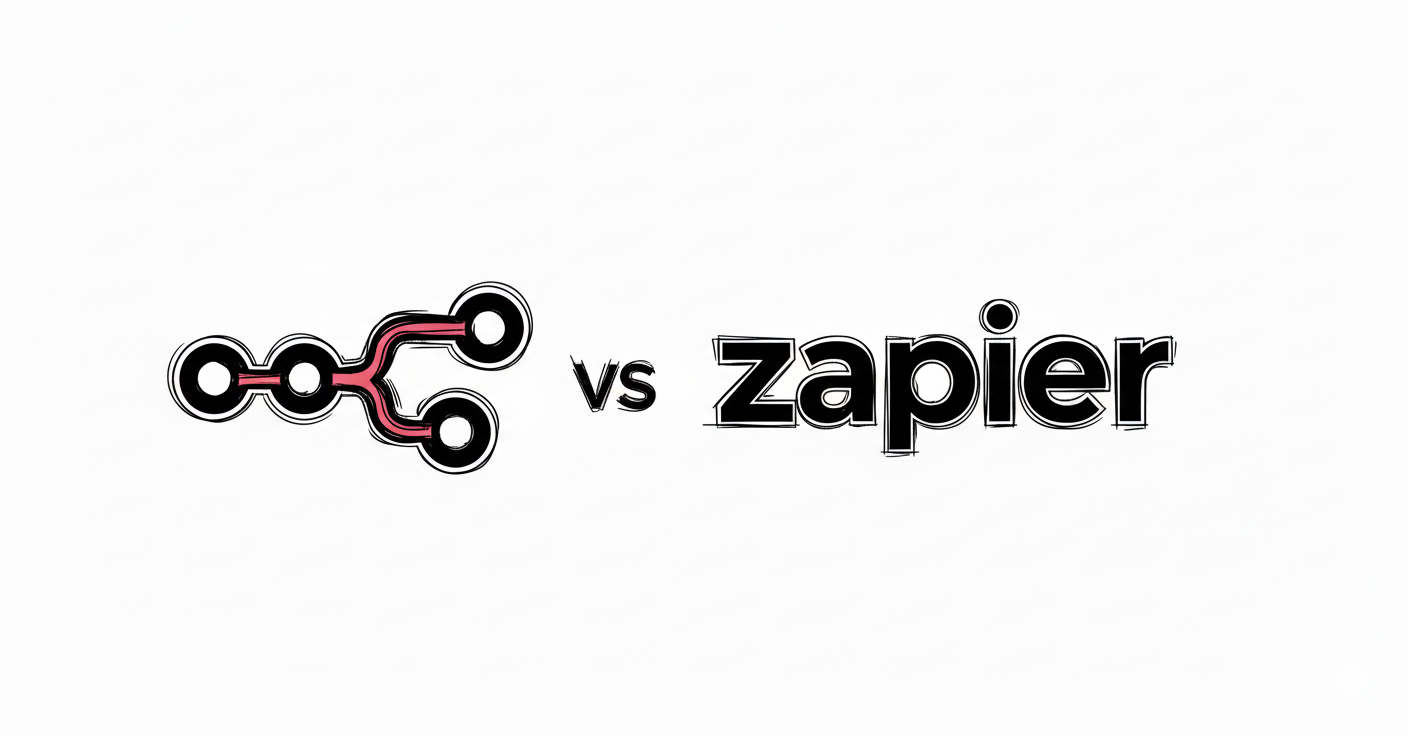The automation landscape has evolved beyond simple “if-this-then-that” workflows into sophisticated AI-driven systems that can make decisions, process context, and orchestrate complex business logic. While most teams debate between n8n and Zapier based on surface-level features, the strategic implications run much deeper - these platforms represent fundamentally different philosophies about data ownership, technical control, and the future of business automation.
The automation wars aren’t just about connecting apps anymore. n8n (launched in 2019) is open-source, low-code, and event-driven. Users design automations by connecting “nodes” on a visual canvas, giving them significant control over logic and data. Meanwhile, Zapier has maintained its position as the no-code champion, focusing on democratizing automation for non-technical teams with over 8,000 app integrations.
But choosing between these platforms isn’t just about counting integrations or comparing price tags. It’s about understanding which automation philosophy aligns with your organization’s technical DNA and strategic direction. The teams getting the most value from either platform understand this distinction clearly.
Two Nuanced Insights That Will Reshape Your Platform Decision
1. n8n’s Self-Hosting Model Creates a Compound Data Advantage
Most discussions about n8n’s self-hosting capability focus on cost savings, but the real strategic advantage is compound data ownership. Self-hosting n8n offers full control over data and workflows, crucial for compliance with privacy regulations like GDPR or CCPA. It also enhances security by removing risks associated with third-party vendors.
This isn’t just about compliance checkbox exercises. Teams that self-host n8n develop what I call “data sovereignty” - the ability to create, store, and process automation data without external dependencies. With n8n’s Code node, you can execute external npm packages and access file system operations - capabilities that aren’t available in cloud-based platforms like Zapier.
The compound effect emerges over time: as your automation complexity grows, your data remains under your control, your processing capabilities expand without vendor limitations, and your costs scale predictably. A business running 50,000+ monthly executions would need to scale beyond n8n Pro’s 10,000 execution limit, reaching approximately €170/month with additional execution blocks, but only $6.99/month ($83.88/year) with Hostinger VPS - saving approximately $1,900 annually.
This creates a divergent path where self-hosted n8n users build increasingly sophisticated systems while cloud-dependent teams hit platform limitations. The gap widens exponentially as automation needs mature.
2. Zapier’s Task-Based Pricing Accidentally Optimizes for Wrong Metrics
Zapier’s task-based pricing model appears straightforward, but it creates an insidious optimization trap that most teams don’t recognize until they’re deep into complex workflows. In Zapier, a task refers to an individual action performed by a Zap, which means complex, valuable automations become disproportionately expensive.
Here’s the hidden dynamic: n8n charges only for complete workflow executions regardless of steps or complexity, making it cost-effective for advanced automation scenarios compared to operation-based pricing models. This pricing philosophy shapes user behavior in profound ways.
Teams on Zapier unconsciously optimize for task minimization rather than outcome maximization. They build simpler workflows to control costs, avoiding the complex conditional logic and data transformations that often deliver the highest business value. It’s like having a gym membership that charges per exercise - you end up doing fewer reps instead of building strength.
Meanwhile, n8n users are incentivized to build richer, more comprehensive workflows because complexity doesn’t increase their costs. The big advantage of n8n Cloud plans is that they do not charge you for the complexity of your workflows, so if your workflow run takes hundreds of actions, you will spend a lot more on Make and Zapier, compared to n8n.
Core Platform Comparison: Where Each Excels
n8n: The Developer’s Automation Platform
n8n positions itself as the technical choice for teams that want maximum flexibility and don’t mind complexity. n8n positions itself as a truly AI-native platform with its advanced integration of LangChain, offering extensive AI nodes dedicated to AI applications.
Strengths:
- True AI Integration: n8n offers vector database storage, AI agent capabilities, and seamless LangChain integration for building sophisticated AI workflows
- Unlimited Complexity: No per-step pricing means you can build intricate workflows without cost penalties
- Code Flexibility: n8n allows to execute Python (since Feb 2023) and JavaScript with external npm packages in self-hosted setups
- Data Sovereignty: Complete control over where your data lives and how it’s processed
Limitations:
- Steeper Learning Curve: n8n presents the most technical interface of the three, with a node-based approach similar to development tools like Node-RED
- OAuth Complexity: For n8n, you need to spend around 10-20 minutes configuring Google Console access and setting up an OAuth client
- Maintenance Overhead: Self-hosting requires infrastructure management
Zapier: The Accessibility Champion
Zapier remains the gold standard for no-code automation, prioritizing ease of use and breadth of integrations over technical sophistication.
Strengths:
- Massive Integration Library: Zapier connects to 8,000+ apps, more than any other automation tool
- Zero Learning Curve: Zapier’s drag-and-drop builder and step-by-step setup make it easy for beginners to create automations without any coding knowledge
- Managed Infrastructure: No server maintenance or OAuth configuration required
- AI Accessibility: Create custom AI chatbots in minutes with Zapier Chatbots, connect them with 8,000+ apps, and automate conversations
Limitations:
- Cost Scaling Issues: For users who have numerous complex workflows running frequently, the number of tasks consumed can skyrocket, compelling upgrades to higher-tier plans
- Technical Constraints: Limited custom logic and no access to file systems or advanced programming capabilities
- Vendor Lock-in: Complete dependence on Zapier’s infrastructure and pricing decisions
Pricing Deep Dive: The Real Cost Analysis
n8n Pricing Strategy
n8n offers multiple deployment options that dramatically affect total cost of ownership:
Cloud Hosting:
- Starter Plan: €20/month for 2,500 executions and 5 active workflows
- Pro Plan: €50/month for 10,000 executions and 15 active workflows
- Enterprise: Custom pricing with unlimited executions
Self-Hosting:
- Community Edition: Free with server costs around €5-10 monthly for basic VPS requirements
- VPS hosting from providers like Hetzner or DigitalOcean starts at €4-€6/month
Zapier Pricing Structure
- Free Plan: 100 tasks per month, 2-step Zaps only
- Professional Plan: Starting at $29.99 per month for 750 tasks, scaling up significantly for higher task volumes
- Team Plan: $103.50 per month for 2K tasks per month
- Enterprise: Custom pricing starting from approximately $799/month for 100K tasks with advanced security features
Real-World Cost Scenarios
For a mid-sized company running 25,000 monthly workflow executions:
n8n Options:
- Self-hosted: ~$10-20/month (server costs only)
- Cloud Pro Plan: €50/month ($55/month)
Zapier Requirements:
- Professional Plan with 25K tasks: ~$183/month
- Annual commitment reduces costs but still significantly higher than n8n
Strategic Decision Framework
Choose n8n When:
Technical Capability Exists Your team has developers or technically-minded operations people who can handle node-based workflows and potentially self-hosting requirements.
Complex AI Requirements For automation projects heavily integrating AI, n8n clearly represents the most powerful option in 2025, especially if you need custom AI models or sophisticated data processing.
Cost Sensitivity at Scale You’re processing high volumes of automation tasks and need predictable, workflow-based pricing rather than per-task billing.
Data Sovereignty Matters Compliance, security, or business requirements demand complete control over where automation data lives and how it’s processed.
Long-term Strategic Investment You’re building automation capabilities as a core competency rather than solving point problems.
Choose Zapier When:
Speed to Value is Critical You need automations running quickly without technical complexity or infrastructure concerns.
Non-Technical Team Zapier’s user-friendly design appeals to non-technical users and small teams who want to focus on business logic rather than technical implementation.
Broad Integration Requirements You need to connect many niche applications and services that may not have n8n nodes available.
Managed Service Preference You prefer paying for fully managed services rather than handling infrastructure, updates, and maintenance.
Simple to Moderate Complexity Your automation needs center around straightforward data movement and basic conditional logic.
The AI Factor: A Game-Changing Differentiator
The integration of artificial intelligence into automation workflows represents the biggest differentiator between these platforms in 2025. n8n positions itself as a truly AI-native platform with its advanced integration of LangChain, offering extensive AI nodes dedicated to AI applications.
While Zapier is adding AI features such as automation suggestions and sentiment analysis, the scope is still quite limited for building full AI-driven processes, n8n provides deep AI capabilities including integrations with tools like OpenAI, Hugging Face, and LangChain for building complete AI workflows, including LLM-powered chatbots, content summarizers, and agents that act on data.
For organizations building AI-first automation strategies, this technical depth creates a significant moat. With support for vector databases and custom model endpoints, n8n is ideal for creating intelligent automation solutions.
The Strategic Verdict
The choice between n8n and Zapier isn’t really about features or integrations - it’s about your organization’s automation philosophy and technical trajectory. Teams that choose n8n are betting on technical depth, cost efficiency at scale, and the value of data sovereignty. Teams that choose Zapier are prioritizing speed, simplicity, and managed convenience.
Both platforms will continue evolving, but their fundamental philosophies remain distinct. n8n offers developers deeper technical control, greater customization, and more ownership of their automation stack, while Zapier’s user-friendly design appeals to non-technical users and small teams.
The most successful organizations I’ve observed don’t just pick a tool - they align their platform choice with their broader technical strategy. If you’re building automation as a competitive advantage and have the technical resources to support it, n8n provides a foundation for sophisticated, cost-effective systems. If you need to democratize automation across your organization and prioritize time-to-value over technical control, Zapier remains the superior choice.
The future belongs to teams that understand this distinction and choose accordingly. In an increasingly automated world, the platform decision you make today will compound into significant strategic advantages - or limitations - over time.
Resources:

